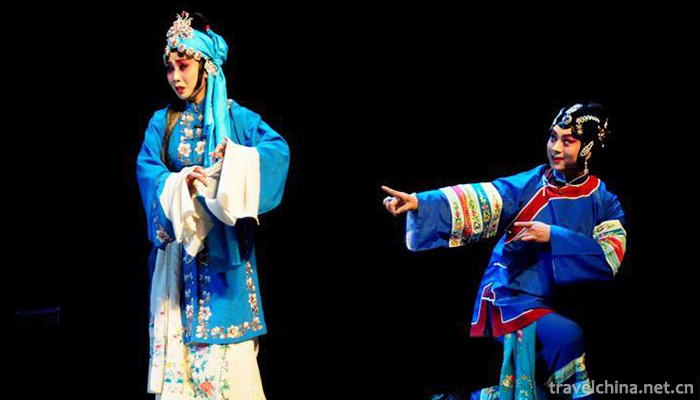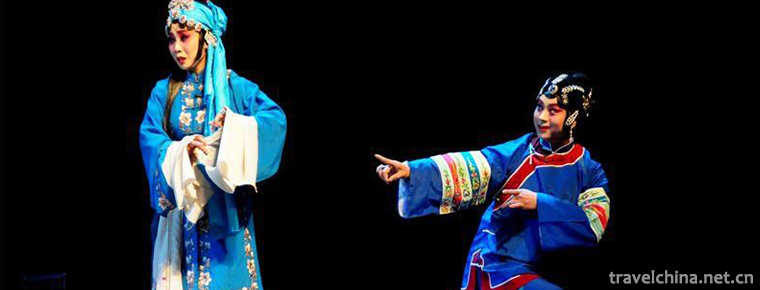Shangdang Erhuang
Shangdang Erhuang
Pihuangqiang in Shangdang area is called Shangdang Erhuang. It is an independent opera with a history of more than 200 years. Locals call it "Tu Erhuang". At present, Shangdang Erhuang is on the verge of being lost.
On May 23, 2011, Shangdang Erhuang was listed in the third batch of national intangible cultural heritage list with the approval of the State Council.
Types of Drama
As a folk art, Shangdang Erhuang's aria is divided into two categories: Xipi and Erhuang, including the anti-Yihuang, which is called Pihuang, and belongs to the board chamber. Western leather has the original board, the second board (divided into slow, medium and fast), loose board and rocker board; the second spring has the positive second spring, the reverse second spring, the second board and the board. Xipi Vocal Tune has the artistic characteristics of roundness, euphemism and crispness. It is easy to express feelings, and is often adopted by Sheng and Dan. The type of the two-spring cavity plate is less and the change is not much. In addition, there is a kind of "flat spring" which has been lost.
Opera Music
Erhuang Opera has a rich and colorful singing tune. It pays attention to singing and doing two functions. Among them, the performance is elegant, simple, delicate and realistic, and the singing tune is mellow, euphemistic and changeable. In the past, Erhuang Opera often performed with Kunqu Opera.
Traditional drama
The traditional repertoires of Shangdang Erhuang include "Striking Golden Branches", "Hanging Dragon Lantern", "Taking Xichuan", "Wuzhangyuan", "Qinghe Bridge" and so on.
Shangdang Erhuang's percussion music in the martial field is different, using drums, boards, baritone gongs, steel*, high-key gongs. The main musical instrument in Wenchang is Beijing Hu and the accompanying instrument is Beijing Erhu.
Current situation of inheritance
Nowadays, due to the depression of the theatre market, the lack of stable income and the lack of security of life, the artists who can sing the second reed of the Party have no intention of receiving apprenticeship, and the second reed of the Party is on the verge of disappearance.


-
1.Shanghai
People's Republic of China municipality directly under the central government
Time 2018-10-12 -
2.Mao tofu Fried bean curd
Mao tofu Fried bean curd is a famous traditional dish in Huizhou, Anhui Province, and is well known for its vegetarian delicacies at home and abroad.
Time 2018-11-27 -
3.Leifeng Memorial Hall in Fushun
The Leifeng Memorial Hall in Fushun City is located at No. 61, East Section of Peace Road, Wanghua District, Fushun City, Liaoning Province. It covers an area of 99900 square meters, near the army sta
Time 2019-01-12 -
4.Thrush valley ecological tourist area
Thrushcross Valley is a natural eco-tourism area, located in Yaoshan Town, Lushan County, Henan Province, and at the northern foot of Yaoshan Scenic Area. It is a national AAAA-level tourist attractio
Time 2019-01-17 -
5.Ming Xiaoling Mausoleum
The Ming Xiaoling Tomb is situated at the south foot of Zijinshan Mountain in Xuanwu District, Nanjing, under Dulongfu Playing Pearl Peak. It is adjacent to Zhongshan Tomb in the East
Time 2019-02-07 -
6.Sun Tzu Cultural Park
Sun Tzu Cultural Park is located in the East New Area of Guangrao County. It has been listed in the "four batches" key dispatching and promotion projects of the Yellow River Delta High Effic
Time 2019-02-13 -
7.Jianchuan Opera
Jianchuan Baiqu is an ancient music variety with a long history and wide spread in Bai nationality area. It is mainly popular in Jianchuan, Eryuan and Tongdian, Jinding and Jiuhe of Lanping County, Nu
Time 2019-05-05 -
8.Lanxi stall spring
Lanxi Spring Spring Spring Spring is an ancient form of sitting and singing art, which was formed and popular in Lanxi area in the Midwest of Zhejiang Province, Jinhua and Quzhou, and belongs to Nanci
Time 2019-05-10 -
9.Wuhan acrobatics
In the 20 years of Qingdaoguang (1840), folk acrobats from Tianmen, Wuyang and other places in Hubei came to Wuhan to perform, and then gradually formed a class club to enter the stage. Folk artists s
Time 2019-06-30 -
10.Production Techniques of Yixing Purple Sand Pottery
Yixing Purple Sand Pottery Manufacturing Techniques, Dingshu Town, Yixing City, Jiangsu Province, local folk traditional pottery making techniques, one of the national intangible cultural heritage.
Time 2019-07-12 -
11.Neijiang social security
In 2019, there were 109600 people participating in the endowment insurance (including retirees) of government institutions, 842500 people of enterprise employees (including retirees), and 1501700 people of urban and rural residents. 52100 new urban jobs
Time 2020-12-16 -
12.Yibin social security
By the end of 2019, there were 1.0302 million people participating in the basic endowment insurance for urban employees, an increase of 25500 over the end of the previous year, and 1.921 million people participated in the basic endowment insu
Time 2020-12-18